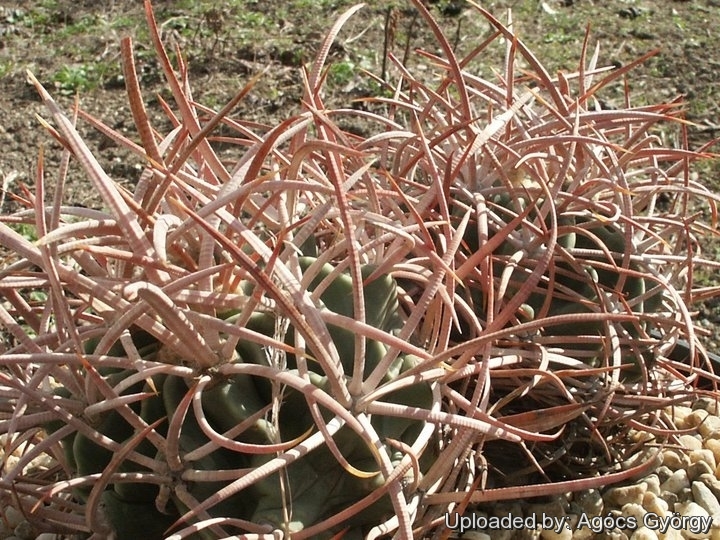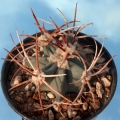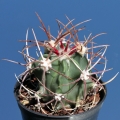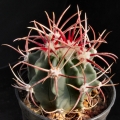
Echinocactus parryi Photo by: Agócs György
Rebutialand cactus collection Demjén, Hungary.
Origin and Habitat: Echinocactus parryiSN|938]]SN|938]] is endemic of Chihuahua, Mexico (extent of occurrence of less than 20,000 km2)
Altitude: 1100 to 1300 metres above sea level.
Habitat: Grows on mountain foothills on rocky and gravely slopes in a very dry deserts environment mostly in xerophyllous scrub. Echinocactus parryiSN|938]]SN|938]] grows solitary or in spreading clumps and is locally abundant. Illegal collection, rock mining and extraction of construction materials affect some subpopulations.
Synonyms:
Description: Globose depressed or shortly cylindrical, remarkably similar in morphology to E. polycephalus but distinct by the manner of growth and whiter spines. This Echinocactus is usually solitary but can branches spontaneously under normal conditions.
Stem: Glabrous, greyish-green, 20 to 30 cm high and 25 to 40 cm. in diameter (but typically under 35 cm in diameter)
Areoles: Roundish, with abundant greyish wool.
Ribs: Approx 13, acute. The juvenile Echinocactus looks quite different from the mature specimens. In fact, as with other Echinocactus and Ferocactus seedlings, the rib structure is not yet completely apparent, and they have pronounced tubercles making them look superficially like Mammillarias.
Spines: Dense, stout, angled, and ringed, chalky white to greyish-pink that turn a darker (redder) colouring when sprinkled with water. The spines almost obscure the plant bodies and restrict the small yellow flowers from opening fully.
Flowers: Yellow. They appear in summer.
Fruits: Woolly
Notes: E. polycephalus complex: This complex is formed by three similar barrel cacti and comprises Echinocactus parryiSN|940]]SN|938]], Echinocactus polycephalusSN|940]]SN|940]] (var. polycephalus), and Echinocactus polycephalusSN|938]]SN|940]] ssp. xeranthemoides. The two varieties of E. polycephalus are indeed not recognized and accepted by all taxomists, in fact studies in the in the field, and distribution maps indicate potential sympatry among them. While herbarium studies, field observations, scanning electron microscopy, and genetic analysis support the distinction of E. parryi and E. polycephalus as separate species.
Bibliography: Major references and further lectures
1) Edward Anderson “The Cactus family” Timber Press, Incorporated, 2001
2) James Cullen, Sabina G. Knees, H. Suzanne Cubey "The European Garden Flora Flowering Plants: A Manual for the Identification of Plants Cultivated in Europe, Both Out-of-Doors and Under Glass" Cambridge University Press, 11/Aug/2011
3) David R Hunt; Nigel P Taylor; Graham Charles; International Cactaceae Systematics Group. "The New Cactus Lexicon" dh books, 2006
4) N. L. Britton, J. N. Rose “The Cactaceae. Descriptions and Illustrations of Plants of the Cactus Family.” Volume 4, The Carnegie Institution of Washington, Washington 1923
5) Curt Backeberg “Die Cactaceae: Handbuch der Kakteenkunde” Gustav Fischer Verlag, Stuttgart New York 1982–1985
6) Corral-Díaz, R. 2013. Echinocactus parryi. In: IUCN 2013. IUCN Red List of Threatened Species. Version 2013.2. <www.iucnredlist.org>. Downloaded on 27 February 2014.
 Echinocactus parryi Photo by: Raimondo Paladini
Echinocactus parryi Photo by: Raimondo Paladini SB59 Cuidad Juarez, Chihuahua, Mexico. Photo by: Valentino Vallicelli
SB59 Cuidad Juarez, Chihuahua, Mexico. Photo by: Valentino Vallicelli Echinocactus parryi Photo by: Raimondo Paladini
Echinocactus parryi Photo by: Raimondo Paladini Echinocactus parryi Photo by: Prof. Ilham Alakbarov
Echinocactus parryi Photo by: Prof. Ilham Alakbarov Echinocactus parryi Photo by: Valentino Vallicelli
Echinocactus parryi Photo by: Valentino Vallicelli Wet spines. Photo by: Valentino Vallicelli
Wet spines. Photo by: Valentino Vallicelli Echinocactus parryi Photo by: Raimondo Paladini
Echinocactus parryi Photo by: Raimondo Paladini Grow it in a very draining mineral soil and provide good ventilation (especially in winter) Photo by: Cactus Art
Grow it in a very draining mineral soil and provide good ventilation (especially in winter) Photo by: Cactus ArtCultivation and Propagation: Echinocactus parryi is a summer grower species that is relatively difficult to grow on its own roots as its roots are particularly rot sensitive in cultivation, especially after planting. It is extremely xerophytic and adapted to very dry soils, but plant grafted are easy to grow and no special skill is required.
Growth rate: Slow-growing and very long-lived. It will make clumps given the best conditions. Plants grown from seed begin to branch at nearly 20 years of age.This cactus continues to be, a particular prize among collectors.
Soils: It likes very porous mineral cactus mix soil, but can become too elongated if compost is too rich.
Repotting: This plant needs plenty of space for its roots, repotting should be done every other year or when the it has outgrown its pot. Use pot with good drainage.
Watering: Needs moderate in summer, but do not overwater (Rot prone), keep dry in winter at a minimum temperature of 0°C.
Fertilization: Feed with a high potassium fertilizer in summer.
Hardiness: Reputedly resistant to frost if kept on the dry side prior to, and during, cold weather (hardy to -12 C ° C, or less for short periods), but for safe cultivation it is best to avoid freezing temperatures. It need a very good ventilation.
Exposition: The plant tolerates extremely bright situations. Blasting full sun encourages flowering and heavy spine production.
Pests & diseases: It may be attractive to a variety of insects, but plants in good condition should be nearly pest-free, particularly if they are grown in a mineral potting-mix, with good exposure and ventilation. Nonetheless, there are several pests to watch for:
- Red spiders: Red spiders may be effectively rubbed up by watering the plants from above.
- Mealy bugs: Mealy bugs occasionally develop aerial into the new growth among the wool with disfiguring results, but the worst types develop underground on the roots and are invisible except by their effects.
- Scales: Scales are rarely a problem.
- Rot: This species is not easy and accommodating, often suffer of cryptogamic diseases. Rot it is only a minor problem with Echinocactus if the plants are watered and “aired” correctly. If they are not, fungicides won't help all that much.
Propagation: Seed or grafting. The seeds germinate with extreme difficulty and a low rate of success. Seedlings did not do well either, and some die each year.
Your Photos

by Valentino Vallicelli

by Valentino Vallicelli

by Prof. Ilham Alakbarov

by Valentino Vallicelli























